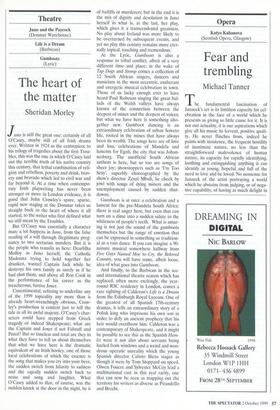Theatre
Juno and the Paycock (Donmar Warehouse) Life is a Dream (Barbican)
Gumboots The heart of the matter
Sheridan Morley
uno is still the great one: certainly of all O'Casey, maybe still of all Irish drama ever. Written in 1924 as the centrepiece to his trilogy of tragedies about the first Trou- bles, this was the one in which O'Casey laid out the terrible truth of his native country this century, that lethal combination of reli- gion and rebellion, poverty and drink, brav- ely and bravado which led to civil war and far beyond it. At a time when contempo- rary Irish playwriting has never been stronger or more in London evidence, it is good that John Crowley's spare, sparse, rapid new staging at the Donmar takes us straight back to the heart of where it all started, to the writer who first defined what we still mean by the Troubles.
But O'Casey was essentially a character man; a lot happens in Juno, from the false reading of a will through illegitimate preg- nancy to two sectarian murders. But it is the people who transfix us here: Dearblha Molloy as Juno herself, the Catholic Madonna trying to hold together her drunken, wastrel Captain Jack while he destroys his own family as surely as if he had shot them, and above all Ron Cook in the performance of his career as the treacherous, furtive Joxer.
Unsentimental, refusing to underline any of the 1999 topicality any more than is already heart-wrenchingly obvious, Crow- ley's production is content just to tell the tale in all its awful majesty. O'Casey's char- acters could have stepped from Greek tragedy or indeed Shakespeare; what are the Captain and Joxer if not Falstaff and Pistol? But so timeless and total are they in what they have to tell us about themselves that what we have here is the dramatic equivalent of an Irish hooley, one of those local celebrations of which the essence is the song that makes you cry into your beer, the sudden switch from hilarity to sadness and the equally sudden switch back to noise and song and laughter. What O'Casey added to that, of course, was the sudden knock at the door in the night, be it of bailiffs or murderers; but in the end it is the mix of dignity and desolation in Juno herself in what is, at the last, her play, which gives it a transcendental greatness. No play about Ireland was more likely to be overturned by subsequent events, and yet no play this century remains more eter- nally topical, touching and tremendous.
At the Lyric, Gumboots is also a response to tribal conflict, albeit of a very
different time and place; in the wake of
Tap Dogs and Stomp comes a collection of 12 South African singers, dancers and
musicians in the most eccentric, exuberant and energetic musical celebration in town. Those of us lucky enough ever to have heard Paul Robeson singing the great bal- lads of the Welsh valleys have always known of the connection between the deepest of mines and the deepest of voices; but what we have here is something alto- gether new. Gumboot dancing is an extraordinary celebration of urban Soweto life, rooted in the mines that have always been its wealth. The songs here are of love and loss, celebrations of Mandela and laments for Egoli, the city that was Johan- nesburg. The unofficial South African anthem is here, but so too are songs of sheer joy; showstoppers such as 'I'm Too Sexy', superbly choreographed by the show's director Zenzi Mbuli, lie cheek by jowl with songs of dying miners and the unemployment caused by sudden shut- downs.
Gumboots is at once a celebration and a lament for the pre-Mandela South Africa;
there is real anger here, but even that can turn on a dime into a sudden salute to the whiteness of people's teeth. What is amaz- ing is not just the sound of the gumboots themselves but the range of emotion that can be expressed in something as tradition-
al as a rain dance. If you can imagine a 9t)- minute musical somewhere halfway from Five Guys Named Moe to Co), the Beloved Country, you will have some, albeit loose. idea of what goes into Gumboots.
And finally, to the Barbican in the sec- ond international theatre season which has
replaced, often more excitingly, the year-
round RSC residency in London, comes a rare sighting of Calderon's Life is a Dream
from the Edinburgh Royal Lyceum. One of
the greatest of all Spanish 17th-century dramas, it tells an extraordinary story of a
Polish king who imprisons his own son in
order to defy an ancient prophecy that his heir would overthrow him. Calderon was a
contemporary of Shakespeare, and it might
be possible to see this as the Spanish Hain- let were it not also about servants being
hurled from windows and a weird and won- drous operatic unreality which the young Spanish director Calixto I3ieto stages as though it were by Tom Stoppard on speed.
Olwen Fouere and Sylvester McCoy lead a multinational cast in this real rarity, one that can now be seen as mapping out the territory for writers as diverse as Pirandello and Brecht.










































































 Previous page
Previous page